 “My first encounter with Noh no Ikebana was an open class held regularly by Midori net–Akita, an Akita-based association that support local agricultural infrastructure development. The idea of making something artistic out of agricultural products moved me so much that I decided to joint the team and help it organize the open classes and promotional activities.
“My first encounter with Noh no Ikebana was an open class held regularly by Midori net–Akita, an Akita-based association that support local agricultural infrastructure development. The idea of making something artistic out of agricultural products moved me so much that I decided to joint the team and help it organize the open classes and promotional activities.
Akita has an active agricultural industry, but not many of Akita people living in urban areas are interested in agriculture. Then, how can I make more people interested in agriculture? I have been thinking about it for a long time. So Noh no Ikebana is the best tool for communicating the charm of agriculture and agricultural products, I think.
People coming to our open classes often talk about vegetables and tools we use for the arrangements. When we use something unfamiliar like yakon potatoes, many want to know how we cook them and where we can buy them.
Those who have nothing to do with the agriculture industry may become interested in Noh no Ikebana. If we have more people involved in Noh no Ikebana, we may also have more people to support the agricultural industry.
The title of this arrangement is “Satoyama (Hilly Countryside) in Late Autumn. A traditional wooden tool used for winnowing, called toumi in Japanese, is featured in the center while rice stalks and wildflowers are added to express the scenery of satoyama in autumn.
<Container> Toumi (traditional winnowing machine)
<Materials> Rice stalks, red peppers, cosmoses, bittersweets, hollyhocks, and tall goldenrods


